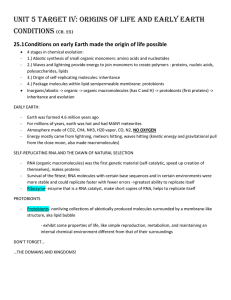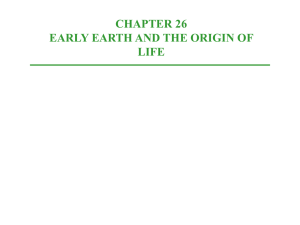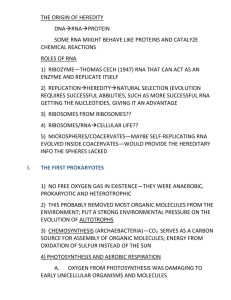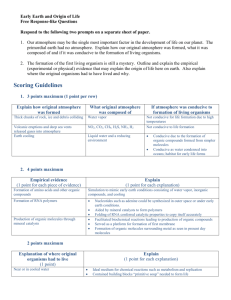History of Life on Earth
advertisement
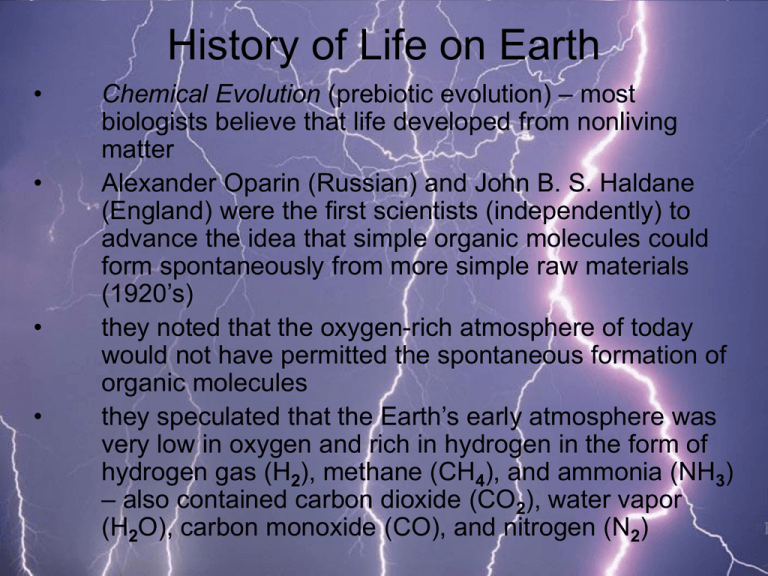
History of Life on Earth • • • • Chemical Evolution (prebiotic evolution) – most biologists believe that life developed from nonliving matter Alexander Oparin (Russian) and John B. S. Haldane (England) were the first scientists (independently) to advance the idea that simple organic molecules could form spontaneously from more simple raw materials (1920’s) they noted that the oxygen-rich atmosphere of today would not have permitted the spontaneous formation of organic molecules they speculated that the Earth’s early atmosphere was very low in oxygen and rich in hydrogen in the form of hydrogen gas (H2), methane (CH4), and ammonia (NH3) – also contained carbon dioxide (CO2), water vapor (H2O), carbon monoxide (CO), and nitrogen (N2) Conditions on primordial Earth • • Earth is about 4.6 billion years old Earth was very hot when first formed four requirements must have existed for chemical evolution: 1. little or no O2 – Earth’s early atmosphere was probably strongly reducing which would cause any free oxygen to react and form oxides and be removed from the atmosphere 2. a source of energy – early Earth was a place of high energy • • • • violent thunderstorms with torrential rainfall widespread volcanic activity bombardment from meteorites (caused cataclysmic changes in crust, ocean, and atmosphere) intense radiation (including UV radiation, since there was no ozone layer and younger suns emit more UV light) 3. presence of chemical building blocks – water, dissolved inorganic minerals (present as ions), and the gases present in the early atmosphere 4. time for molecules to accumulate and react with one another – Earth is approximately 4.6 billion years old, the earliest traces of life are approx 3.8 billion years old Oparin and Haldane’s hypothesis is tested by Stanley Miller and Harold Urey in the 1950’s • they designed a closed apparatus that simulated conditions that presumably existed on early Earth • they exposed an atmosphere rich in H2, CH4, H2O, and NH3 to an electrical discharge to simulated lightening • analysis of the chemicals produced in a week revealed that amino acids and other organic molecules had formed • • • recent evidence indicates that organic polymers may have formed and accumulated on rock or clay surfaces (rather than in a “primordial soup” in the sea) clay consists of microscopic particles of weathered rock and may have acted as a site for early polymerizations because it binds organic monomers and contains zinc and iron ions that might have served as catalysts lab experiments using clay have confirmed that organic polymers form spontaneously from monomers on hot rock or clay surfaces • • Protobionts – scientists have been able to synthesize several different protobionts (assemblages of abiotically produced organic polymers) exhibit many characteristics of living cells – division after growth, maintaining an internal environment different from the external fluids Microspheres • protobionts formed by adding water to polypeptides • microspheres show an electrical potential, may absorb materials from the surrounding environment • microspheres may give clues as to the evolution of the cell membrane • membranes are made of phospholipid bilayers with proteins • scientists have heated amino acids without water and produced long protein chains – when water is added, stable microspheres (coacervates) are formed • microspheres can accumulate compounds inside them and become more concentrated than outside, they also attracted lipids and formed a lipid-protein bilayer around them Protobionts Microsphere Liposome The first cells probably assembled from organic molecules • Cells were evident in microfossils 3.5 billion years old, perhaps even 3.8 billion years ago • The first cells were prokaryotic • Stromatolites offer more fossil evidence – rocklike columns composed of many minute layers of prokaryotic cells (usually cyanobacteria) • living stromatolite reefs are still found in hot springs and in warm, shallow pools of fresh and salt water Fossilized Stromatolites – 3.5 billion years old Modern day stromatolites • • A crucial step in the origin of cells was molecular reproduction both DNA and RNA can form spontaneously on clay, so… which came first? • • • • • RNA is self-catalytic and is believed to have appeared first (according to the proposed model of the “RNA World”) chemistry of prebiotic Earth gave rise to selfreplicating RNA that functioned both as enzyme and substrates for their own replication RNA has catalytic properties – enzymatic RNAs are called ribozymes (in modern cells, ribozymes help catalyze the synthesis of RNA and process precursors into rRNA, tRNA, and mRNA) ribozymes may have catalyzed the synthesis of RNA, and processed RNA molecules RNA could also catalyze protein formation (catalyzes peptide bonds formation) – protein catalysis of RNA formation happen later • • • DNA probably evolved after RNA – it’s a more stable molecule may have evolved from RNA making double stranded copies of itself stability of DNA provides advantages as the information storage molecule • • • • The first cells were probably heterotrophs fermented organic molecules from the aqueous environment – appeared 3.1 – 3.4 billion years ago first cells were anaerobes, free O2 not available as concentration of free organic molecules in environment declined, photosynthetic organisms had a selective advantage • • • first photosynthetic organism were autotrophs which split H2S as a hydrogen donor (purple and green sulfur bacteria) the first photosynthetic organisms to use H2O as a hydrogen donor were the cyanobacteria (released O2 as by-product) source of the first free oxygen in aquatic environment and atmosphere – O2 existed in significant quantities by 2 billion years ago • • • • • Aerobes appeared after oxygen increased in atmosphere aerobic respiration was “added” to glycolysis after free O2 became available aerobic organisms are much more efficient in converting glucose to ATP carbon dioxide produced helped to stabilize concentration of CO2 and O2 in atmosphere (byproduct of each process – photosynthesis and aerobic respiration – are raw materials for other process) O3 begins to accumulate in upper atmosphere to form ozone (protection from UV radiation) – allows organisms to live in more shallow water and ultimately on land Evolution of Eukaryotic cells • • • • • evolved from prokaryotes about 2 billion years ago Endosymbiont Theory – first proposed by Lynn Margulis – suggests that mitochondria were originally independent prokaryotic aerobic organisms which developed a symbiotic relationship with another prokaryote aerobic prokaryote was engulfed by endocytosis but not digested aerobic prokaryote continued to function and formed a symbiotic relationship with host similar process occurred later with the host cell and photosynthetic prokaryotes (which became chloroplasts) other evidence: • mitochondria and chloroplasts grow and divide like cells • they have a naked loop of DNA like prokaryotes • they synthesize some of their own proteins using 70s ribosomes, like prokaryotes • they have double membrane as expected since cells were taken into a vesicle by endocytosis • cristae are similar to mesosomes of prokaryotes • thylakoids are similar to structures containing chlorophyll in photosynthetic prokaryotes Theories for the Origin of Species • • • • • Lamarck Darwin-Wallace Panspermia – life may have originated elsewhere and come to Earth from space Comets contain a variety of organic compounds and may have delivered both organic compounds and water to early Earth Special Creation – followers of many religions believe that God created life • • • • • • • • Evidence for Evolution Evidence from geographical distributions (biogeography) if evolution did not occur, we would expect to find a given species everywhere that it could survive – in reality this does not occur example – Australia (a separate land mass for millions of years) has distinctive animals (marsupials and monotremes) not found anywhere else 200 million years ago, Australia and other continents were joined together (Pangea) Australian continent gradually separated from others monotremes and marsupials continued to thrive and diversify in Australia isolation of Australia prevented placental mammals (which arose elsewhere at a leter time) from competing with monotremes and marsupials in other areas of the world, placental mammals outcompeted the marsupials and monotremes (which were eliminated) Evidence from biochemistry • • • • all living organisms use DNA (or RNA) as their genetic material all use the same universal genetic code all use the same 20 amino acids in their proteins Variations in specific biochemical molecules can indicate phylogeny (line of evolutionary evidence) – phylogeny can be studied by comparing the structure of a protein or other biochemical – hemoglobin is often used – amino acid sequences of vertebrates are compared for the number of differences – the more difference there is, the longer the timespan since the two species had a common ancestor – evidence seems to show that differences tend to accumulate at a constant rate – differences can be used as an evolutionary clock Evidence from homologous anatomical structures • at an early age, vertebrate embryos are very similar • limbs of vertebrates show striking similarities in their bones, despite being used in many different ways • ex. pentadactyl limb – this limb has a basic pattern of bones including 5 digits (fingers/toes) – pentadactyl limb is used differently by different mammals – appearance varies but same basic structure Evidence from Paleontology – based on fossil record • fossils are difficult to explain without evolution • examples: evolution of horse, Archaeopteryx • fossil record provides direct evidence for evolution • fossils range from bone, teeth, shells, to actual body parts preserved in bogs, tar, amber or ice • Fossils most commonly form in aquatic environments and typically form in sedimentary rock Various methods are used to determine the age of fossils • Radioactive dating – radioisotopes decay in a characteristic and known rate • Half-life is the amount of time required for 50% of the radioisotope to decay – at the end of this period of time (any where from fractions of seconds to thousands of years, depending on isotope) radioactivity will be half of what it was before • • • • • • • • • Carbon dating – excellent method of determining the age of organic material (relatively young, tens of thousands of years old) uses radioactive isotope of carbon, Carbon-14 14C is unstable and spontaneously changes to 14N all living organisms contain 14C in the same proportion as found in the atmosphere when organisms dies, process of incorporating new carbon into body stops (ie, feeding) half-life of carbon is 5730 years Potassium-40 is used to date very old fossils (hundreds of millions of years old) 40K decays to form 40Ar half-life of Potassium-40 is 1300 million years Modern examples of observed evolution • • • • • • Darwin’s finches – finches of the Galapagos islands all finches range in size, 10-20 cm long and are of brownish or black coloration shapes of beaks varied greatly from island to island based on different feeding habits resulting from different selective pressures Rosemary and Peter Grant studied two species of finches on the Galapagos – Geospiza fortis and Geospiza scandens G. fortis had a short, wide beak for feeding on large, hard seeds - during 1982-83 there was a severe El Nino bringing heavy rain and changing the vegetation – by 1991, only 37% of the original population remained and those on average had longer more narrow beaks (compared to the original population) to eat the new smaller softer seeds being produced the population of G. scandens on the same island did not change over that time since its food and diet remained the same • other examples include the Peppered Moth in England, insect resistance to pesticides, antibiotic resistance in bacteria (through mutations or by transfer of plasmids with resistance genes btw bacteria)
